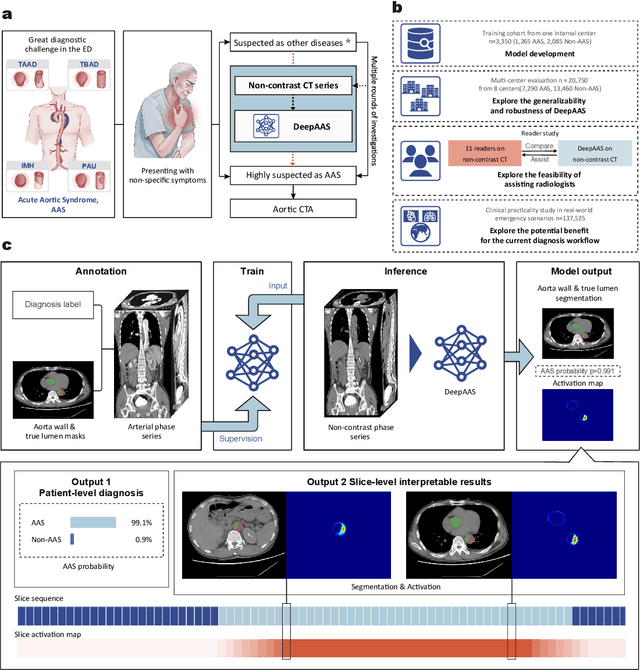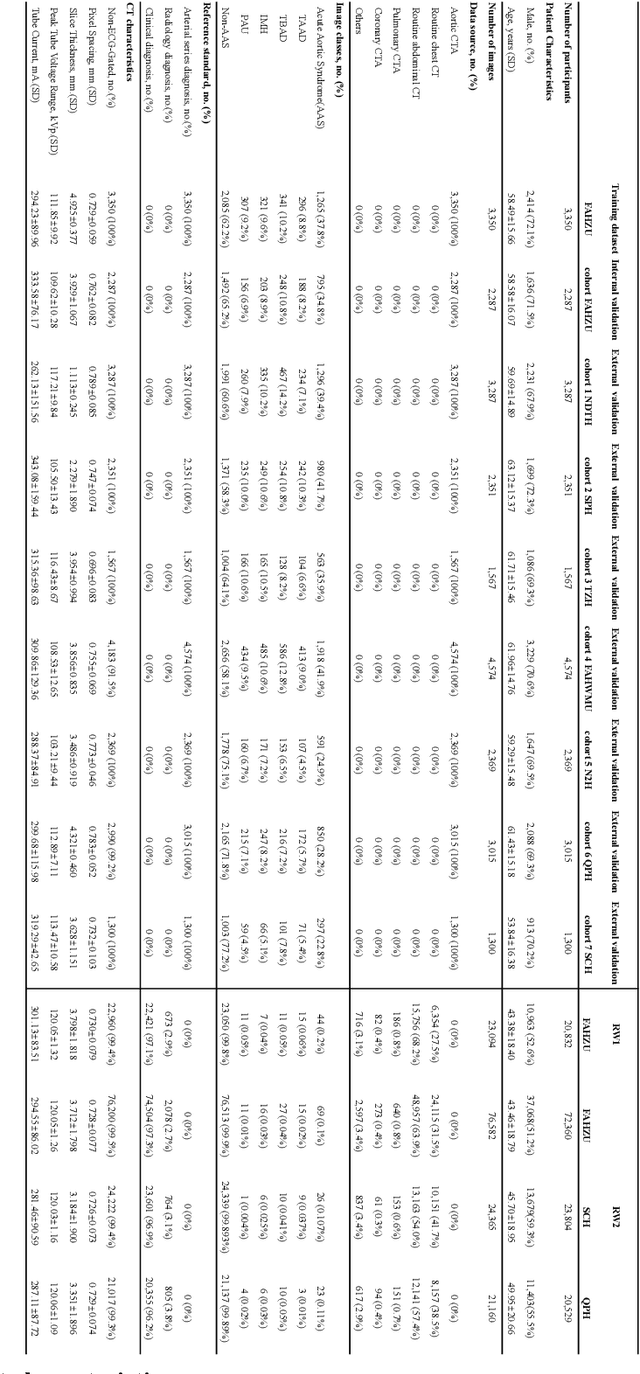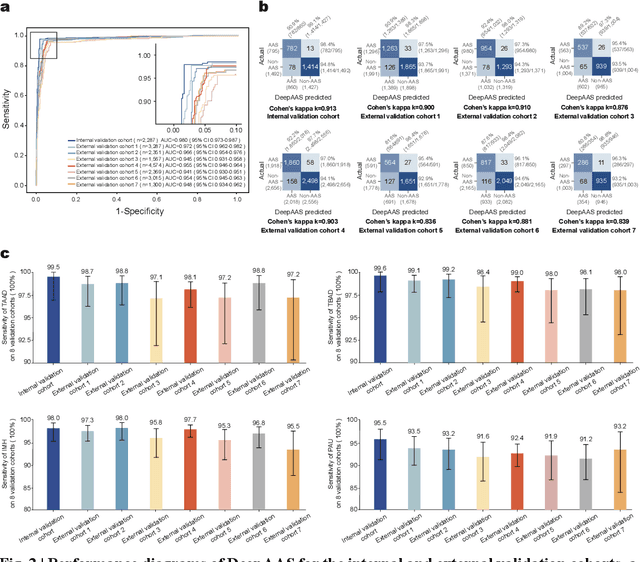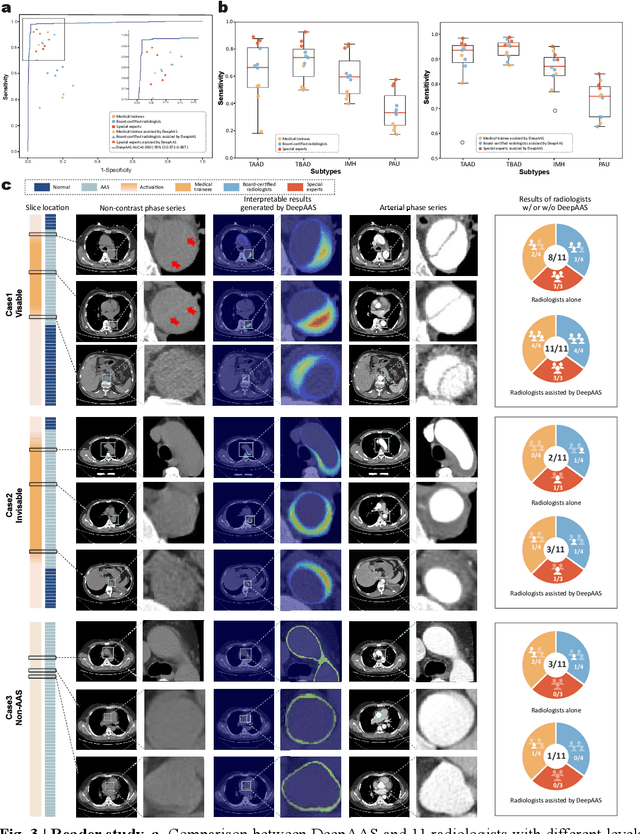Xiaolong Du
Rapid and Accurate Diagnosis of Acute Aortic Syndrome using Non-contrast CT: A Large-scale, Retrospective, Multi-center and AI-based Study
Jun 25, 2024



Abstract:Chest pain symptoms are highly prevalent in emergency departments (EDs), where acute aortic syndrome (AAS) is a catastrophic cardiovascular emergency with a high fatality rate, especially when timely and accurate treatment is not administered. However, current triage practices in the ED can cause up to approximately half of patients with AAS to have an initially missed diagnosis or be misdiagnosed as having other acute chest pain conditions. Subsequently, these AAS patients will undergo clinically inaccurate or suboptimal differential diagnosis. Fortunately, even under these suboptimal protocols, nearly all these patients underwent non-contrast CT covering the aorta anatomy at the early stage of differential diagnosis. In this study, we developed an artificial intelligence model (DeepAAS) using non-contrast CT, which is highly accurate for identifying AAS and provides interpretable results to assist in clinical decision-making. Performance was assessed in two major phases: a multi-center retrospective study (n = 20,750) and an exploration in real-world emergency scenarios (n = 137,525). In the multi-center cohort, DeepAAS achieved a mean area under the receiver operating characteristic curve of 0.958 (95% CI 0.950-0.967). In the real-world cohort, DeepAAS detected 109 AAS patients with misguided initial suspicion, achieving 92.6% (95% CI 76.2%-97.5%) in mean sensitivity and 99.2% (95% CI 99.1%-99.3%) in mean specificity. Our AI model performed well on non-contrast CT at all applicable early stages of differential diagnosis workflows, effectively reduced the overall missed diagnosis and misdiagnosis rate from 48.8% to 4.8% and shortened the diagnosis time for patients with misguided initial suspicion from an average of 681.8 (74-11,820) mins to 68.5 (23-195) mins. DeepAAS could effectively fill the gap in the current clinical workflow without requiring additional tests.
Passive Non-Line-of-Sight Imaging with Light Transport Modulation
Dec 26, 2023Abstract:Passive non-line-of-sight (NLOS) imaging has witnessed rapid development in recent years, due to its ability to image objects that are out of sight. The light transport condition plays an important role in this task since changing the conditions will lead to different imaging models. Existing learning-based NLOS methods usually train independent models for different light transport conditions, which is computationally inefficient and impairs the practicality of the models. In this work, we propose NLOS-LTM, a novel passive NLOS imaging method that effectively handles multiple light transport conditions with a single network. We achieve this by inferring a latent light transport representation from the projection image and using this representation to modulate the network that reconstructs the hidden image from the projection image. We train a light transport encoder together with a vector quantizer to obtain the light transport representation. To further regulate this representation, we jointly learn both the reconstruction network and the reprojection network during training. A set of light transport modulation blocks is used to modulate the two jointly trained networks in a multi-scale way. Extensive experiments on a large-scale passive NLOS dataset demonstrate the superiority of the proposed method. The code is available at https://github.com/JerryOctopus/NLOS-LTM.
 Add to Chrome
Add to Chrome Add to Firefox
Add to Firefox Add to Edge
Add to Edge